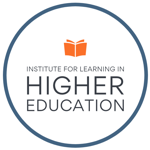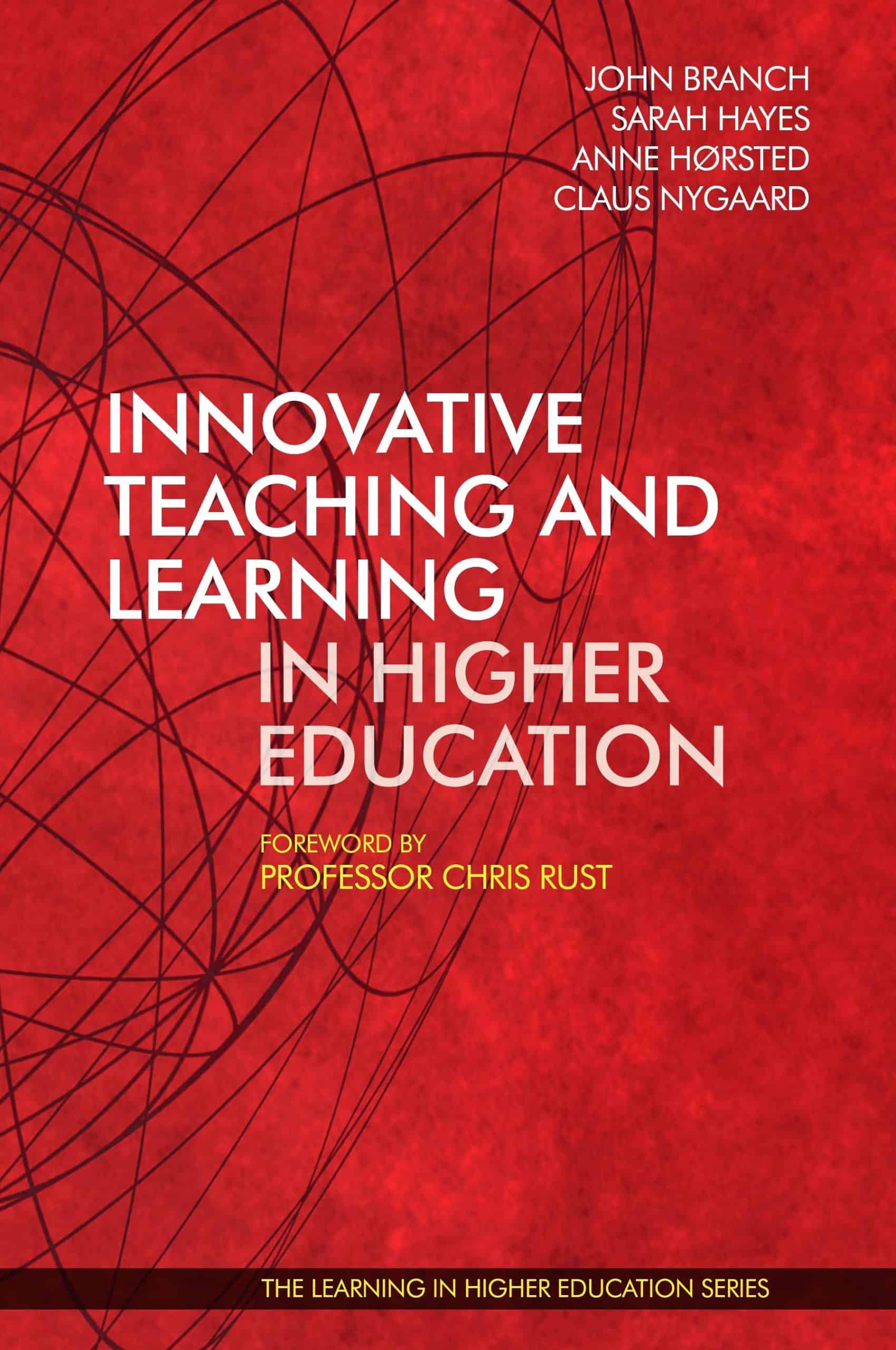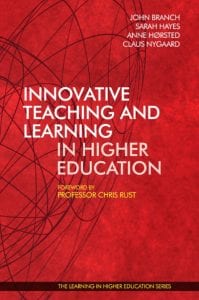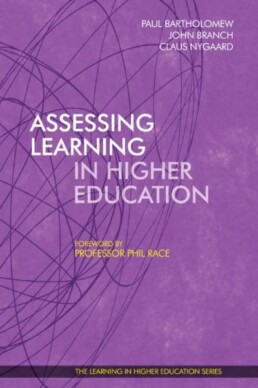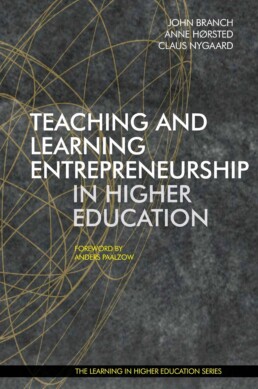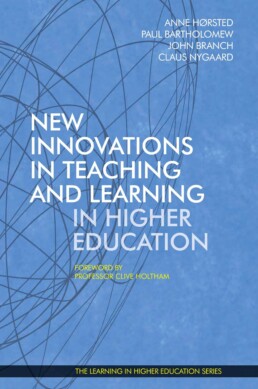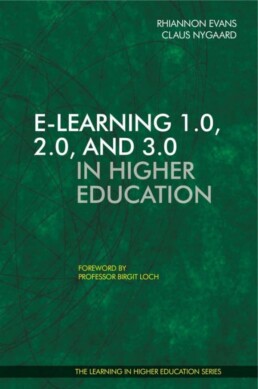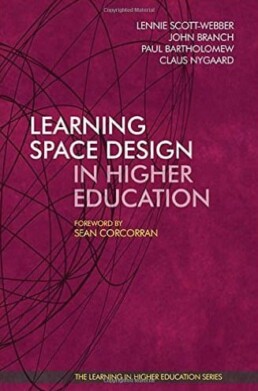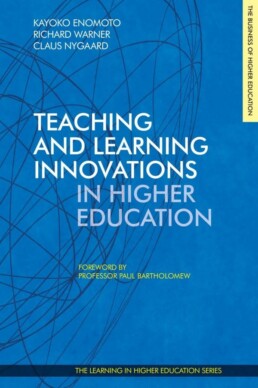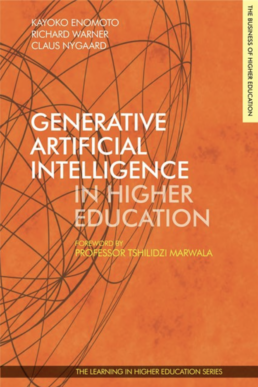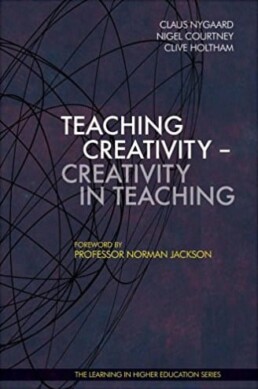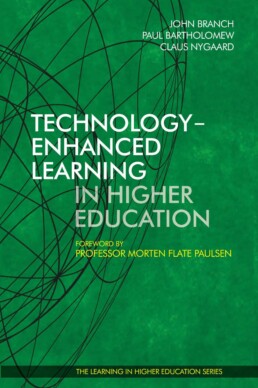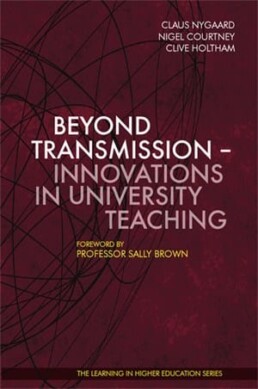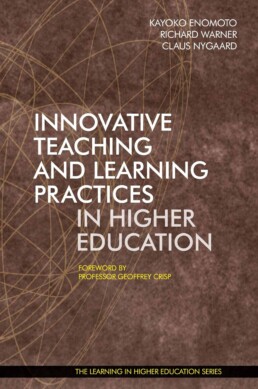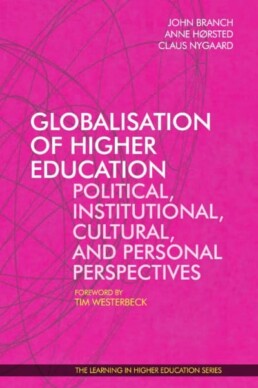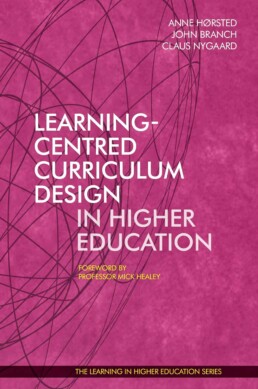Innovative Teaching and Learning in Higher Education (BOOK)
This book holds twenty-seven inspiring examples of innovative teaching and learning, which have improved student engagement and student learning outcomes.
All authors argue that their innovative approach has helped students to learn differently, better, and more.
For those involved in higher education, there is a lot to be gained from reading these narrative accounts of innovative teaching and learning.
100 in stock
Description
Innovative Teaching and Learning in Higher Education
This book holds twenty-seven inspiring examples of innovative teaching and learning, which have improved student engagement and student learning outcomes. All authors argue that their innovative approach has helped students to learn differently, better, and more. For those involved in higher education, there is a lot to be gained from reading these narrative accounts of innovative teaching and learning.
About the Editors
John Branch is the Academic Director of the part-time MBA programmes and Assistant Clinical Professor of Business Administration at the Stephen M. Ross School of Business, and Faculty Associate at the Center for Russian, East European, & European Studies at the University of Michigan in Ann Arbor, U.S.A.
Sarah Hayes is Senior Lecturer in Technology-Enhanced and Flexible Learning in the Centre for Learning Innovation and Profession Practice at Aston University in Birmingham, England.
Anne Hørsted is Adjunct Professor at Syddansk Universitet, Senior Consultant at cph:learning in Denmark, and Adjunct Professor at the Institute for Learning in Higher Education.
Claus Nygaard is Professor and Executive Director of the Institute for Learning in Higher Education and Executive Director of cph:learning and the Steelcase Active Learning Centre in Copenhagen.
Published: 2017
Pages: 444
ISBN: 9781911450085
Overview of the Content
This book holds 27 chapters which all discuss and showcase Innovative Teaching and Learning in Higher Education. The chapters are grouped into 6 sections:
· Section 1: Innovation through Play, Role-Play and Games in Higher Education;
· Section 2: Innovative Teaching and Learning Practices Using Student Partnerships;
· Section 3: Teaching and Learning Innovations Using Modern Technologies;
· Section 4: Innovation through Case-based Teaching and Learning;
· Section 5: Innovation through Authentic Learning-Environments, Experiences and Field Work;
· Section 6: Innovative Teaching and Learning practices using E-learning.
—oOo—
Section 1, Innovation through Play, Role-Play and Games in Higher Education, holds 4 chapters.
In chapter 2, Managing conflict through Role-Play, Salh provides a practical exercise that reflects a multi-layered workplace dispute explored via a role-play scenario. Drawing upon academic and practical knowledge, students work together to unpack a range of issues. This collective approach ensures students emerge through this process with an enhanced understanding of their subject area by using fun.
In chapter 3, Role-playing in the Traditional Classroom, Blended Learning, and eLearning, Mackey explores the strengths and challenges of three modalities for role-playing. The chapter includes practical advice and examples of role-playing in the traditional instructor-led classroom, in blended learning, which combines technology-enhanced learning with the traditional classroom, and in eLearning, in which students learn entirely online, whether synchronously or asynchronously.
Chapter 4, Language Learning through Engaging in Online Role Play, highlights the advantages offered by interactive online role-play in language learning. This practical example presented by Ludewig-Rohwer demonstrates how teachers can use flexibility and anonymity to create a fun and safe learning environment that encourages autonomous learning through creative discussion.
Chapter 5, Assisting Pre-service Educators to Understand Lesson Planning. Planning not to Fail, by Jansen van Vuuren, provides lecturers with three ideas for teaching lesson planning. These ideas incorporate various learning styles, intelligences and human drives to ensure that as many students as possible are reached in an effective yet fun way. A computer-based lesson planning exercise is complemented by a floor puzzle and board game to enrich the learning experience.
—oOo—
Section 2, Innovative Teaching and Learning Practices Using Student Partnerships, holds 6 chapters.
In chapter 6, Exploring feelings through reflective poetry writing, Jack presents the use of reflective poetry writing to explore thoughts and feelings about nursing practice.
In chapter 7, STA(r)s in the Classroom: Supporting Collaborative Learning with Student Teaching Assistants, Bale describes the use of Student Teaching Assistants (STAs) in Modern Language lessons. He shows how the use of STAs goes a step further than peer-assisted learning, as students have a visible presence in the classroom and help plan lesson content based on their knowledge of their fellow students’ needs.
In chapter 8, Beyond engagement and enhancement – piloting a ‘digital student partnership’ to co-teach academic staff on our Post Graduate Diploma in Higher Education, Hayes explains how she had success by engaging undergraduate students to co-teach a group of educators with her, in a student-staff partnership.
In chapter 9, TAPs – Text Analysis Presentations, Bhoola presents how students can improve major language skills, reading comprehension, critical thinking, discussion skills and group work by giving Text Analysis Presentations (TAPs).
In chapter 10, Connecting Theory Through Practice: Transformational Learning in Pre-Service Teacher Education, Kalyn shares how teacher candidates connect practical learning experiences and knowledge acquisition in a Physical Education methods course.
In chapter 11, Extended Flipped Classroom – using peer dynamics for integrative learning, Johnsson et al. introduce a novel method that uses peer dynamics for integrative learning, referred to as Extended Flipped Classroom (EFC). It aims to enhance learning and mimic work-life learning situations.
—oOo—
Section 3, Teaching and Learning Innovations Using Modern Technologies, holds 3 chapters.
In chapter 12, Utilizing recorded lectures and simple mobile phone Audience Response Systems in a Modified Flipped Classroom-Peer Instruction format, Fadel is using a combination of recorded lectures and a simple mobile phone application as an ARS in a Modified Flipped Classroom-Peer Instruction format to provoke peer discussion and learning.
In chapter 13, Enhancing the Physical World with Augmented Reality (AR), Watson uses AR to create digitally interactive 360° physical learning environments in a hybrid style of Flipped Classroom.
In chapter 14, The Application of Tangible User Interfaces for Teaching and Learning in Higher Education, De Raffaele et al. are using TUIs for non-front loaded Flipped Classrooms to aid in the Teaching and Learning of Abstract Concepts within Higher Education.
—oOo—
Section 4, Innovation through Case-based Teaching and Learning, holds 3 chapters.
In chapter 15, Collaborative engagement in case-studies through Learning Technology, Eley & Faniglione look at an approach to address, at least in part, the issue of limited collaborative case-study engagement by students outside the classroom environment. They describe a trial study of an innovative platform for collaborative and progressive work on, and use of, case-studies.
In chapter 16, Teaching Responsible Management Practices via Cases, Svendsen gives insight into the teacher’s reflections in connection with organizing a course on corporate communication and including reflections on responsible management practices to fulfil the university’s strategic aims. Her chapter also contains reflections on how best to facilitate student learning by using cases that play into corporate communication and responsible management philosophy and what the teacher’s role should be in this process.
In chapter 17, Psychology students as co-creators in designing an innovative case-study based learning resource, Faniglione et al. present innovative approaches related to students as partners at Birmingham City University. Academic staff and students have been working in partnership to identify areas of the Psychology curriculum, which could benefit from greater links between theory and practice. Consequently, the proposed solution was to co-create an interactive multimedia resource that allows learners to explore all the stages involved in taking a clinical assessment or developmental history interview.
—oOo—
Section 5, Innovation through Authentic Learning Environments, Experiences and Field Work, holds 4 chapters.
In chapter 18, Integration method to create innovative business ideas and to learn multicultural team working skills, Ahonen & Heikkinen focus on developing and testing business ideas. This method is used to demonstrate to business students what kind of aspects they have to consider when creating new business ideas. The method aims to create an authentic learning experience for students. The authentic experience creates strong memories which can be used later in their studies as a framework for knowledge to be attached. Simultaneously it is offering the students opportunities to identify their strengths and become familiar with their fellow students.
In chapter 19, Teaching academic writing against the grain: A project-based approach, Ip introduces the innovative teaching and learning practice designed for an academic writing course. Students experience a complete, systematic and authentic research process organized according to the project-based learning approach. The process is achieved through an inter-university collaboration. Students in small teams collect data relevant to any social issues of their interest. The data are used to generate two outcomes – an academic research paper for students of one university and a business plan for students of the other university. With this practice, students develop hands-on research skills and learn academic literacy more effectively. The collaborative experience also enhances their social and communication skills by working in multidisciplinary and multicultural teams.
In chapter 20, Multiple tools for innovative interdependent learning techniques in higher education to foster employability skills, Younis describes an experience of the multiple tools that are used to ensure the transfer of knowledge from theory to practical fieldwork application. The tools are used in the British University in Egypt, where various modules are taught in the Business department to ensure meeting the intended learning outcomes and developing transferable skills to ensure a high degree of employability in the market. The intention is to prepare graduates for both local and international employment by applying several methods in the course of their higher education at the university.
In chapter 21, Building motivated student engagement through demonstrated curriculum relevance, Benvenuti describes an approach to curriculum design and implementation that encompasses not only consideration of what students need to know and be able to do but a broader view that looks at the context in which they will one day need to do it. Learning outcomes for the courses include focusing on the personal attributes and values related to students’ future careers and an aspect of self-directed learning. Students define their specific learning outcomes and ways to develop these. By strongly emphasizing the curriculum’s relevance to their future desired careers, it is hoped that high student engagement over a sustained period will be encouraged.
—oOo—
Section 6, Innovative Teaching and Learning practices using E-learning, holds 7 chapters.
In chapter 22, Promoting Self-Regulated Language Learning through a Technology Enhanced Content-based Classroom, Koç shows how technology can encourage students to be independent learners. The concordance analysis program extended students’ vocabulary by allowing them to see and search for lexical combinations used in different contexts independently. The Moovly tool allowed students to work together to create presentations independently while deciding what kind of information was to be extracted from the different websites they accessed. By using these tools, students improved their cognitive and social strategies. Students not only scan and search for information, but they also evaluated information and made independent decisions. They worked collaboratively and with peers in groups.
In chapter 23, Promoting Language Skills through Teacher-structured out-of-class ICT Activities in Higher Education Context, Inozu & Gorgun show how blogging and podcasting provide students with an ample amount of listening experience in a foreign language learning process. The main motive for using these digital tools was to extend in-class work to the outside of the classroom to have access to teacher-structured materials and activities delivered in a self-study mode. Integration of digital technologies enables the teacher to extend the classroom beyond its physical borders. It allows the students to study in their private or preferred environment without time and place constraints. Lower levels of anxiety, improved self-efficacy perceptions, and increased motivation are the further benefits of this instructional design.
In chapter 24, Impact of eLearning: Looking past the hype. The impact of two Life Science courses on global learners, Perumalla et al., present the Faculty of Medicine’s online courses at the University of Toronto (UofT) using the Blackboard (Bb) Learning Management. The flexibility and robustness of Bb provide instructors in creating a “virtual learning environment” by the ability to manage the course content, including posting videos and other learning modules, administer online assessments (quizzes), submit assignments and also manage Grade Book where students can access their respective grades. It provides a “one-stop-shop” for the students, where they access course material, create a community of learners through chat and discussion boards, and easily and conveniently access bulk announcements.
In chapter 25, Stimulating Self-Regulated and Self-Directed Learning Through Technology Enhanced Learning Environment, Koç shows examples that allow learners to create their learning path using Webspirationpro with feedback from teachers in the form of a concept map. As the learners choose their path, they can use the necessary resources from the videos uploaded by the teacher. Also, learners’ freedom was extended to create evaluation schemes by negotiating with the teacher and peers in line with self-directed learning principles. Students used moodle and YouTube for assignment and resource sharing.
In chapter 26, Modelling the use of Google Applications for Education and social media as building blocks for student teachers’ TPACK, du Plessis at the University of Mpumalanga in South Africa proposes the use of freely available solutions such as Google Applications. The absence of a Learning Management System necessitated using time-saving scripts such as Doctopus in conjunction with Google Drive and Flubaroo in conjunction with Google Sheet. This proved particularly useful for teaching technology as part of the students’ teacher training, and the implementation of certain social media applications created opportunities to model these applications to help facilitate teaching about technology.
In chapter 27, A reduced attendance model of delivery that engages remote learners in the workplace, Lewis shows the utilisation of a range of digital technologies in Dental studies. Adobe Connect Pro (video conferencing software) is used for polls, presentations, collaboration, and breakout groups. This increased access to the programme for geographically remote and academically disparate learners. Moodle (VLE) is used for Lessons, Books, Quizzes, and Mahara for e-portfolio. Work-Based Learning and Professional Practice outcomes provide a single point of access to learning resources (to increase access and consistency of material presentation and format). YouTube allows access to practical demonstrations. The benefits to students are that we provide contextualisation and application of learning to the workplace – and workplace activity to the learning. Access to practical demonstrations of processes through video clips and rewards work-related activity with academic credit.
In chapter 28, How Do We Hybridise x and c MOOC Architectures to Create a Course on Online CVs?, McGuire describes his work with an online course at the University of Glasgow. It is a global, free, completely open online course with no entry requirements, not targeted at a specific group. It is a trans-discipline initiative that is cross-cutting in that it is targeted at all careers and is also supportive of academic-professional/work transitions. It aimed to improve employability by developing ‘digital’ or online curriculum vitae (CV) writing skills, and it involved liaison with a wide range of internal and external partners.
Together these inspiring examples of Innovative Teaching and Learning in Higher Education show a large diversity in their approach to innovative teaching and learning practices. And at the same time, they somewhat show a homogeneous effect on student engagement and student learning outcomes. They all argue that their innovative approach has helped students learn different, better, and more. If we take their words for granted, there is a lot to gain from reading the narrative accounts of innovative teaching and learning in this book. Happy reading!
